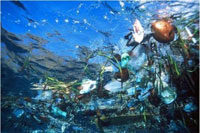 We have previously posted about the plastic “garbage patches” in both the Atlantic and Pacific Oceans – great current vortexes where floating plastic trash has accumulated. As reported in Scientific American scientists studying the garbage patches have noticed that despite that their size has stayed relatively constant despite an steady influx of plastic into the oceans, raising the question “where is all the plastic going?” It may be breaking up into smaller pieces and/or sinking or it may be being easting by marine life and entering the the food chain. The best answer is that no one knows.
We have previously posted about the plastic “garbage patches” in both the Atlantic and Pacific Oceans – great current vortexes where floating plastic trash has accumulated. As reported in Scientific American scientists studying the garbage patches have noticed that despite that their size has stayed relatively constant despite an steady influx of plastic into the oceans, raising the question “where is all the plastic going?” It may be breaking up into smaller pieces and/or sinking or it may be being easting by marine life and entering the the food chain. The best answer is that no one knows.
Ocean garbage patches are not growing, so where is all that plastic going?
The researchers from Sea Education Association (SEA), Woods Hole Oceanographic Institution (WHOI) and the University of Hawaii (UH) found, among other things, that the amount of plastic picked up by the researchers’ nets remained pretty stable over the years, despite society’s increased production and consumption of plastic, according to research published in Thursday’s issue of Science Express.
More than 64,000 individual plastic pieces were collected at 6,100 locations that were sampled yearly over the course of the study. To collect these data, ships towed nets along the water’s surface at each location, and researchers used tweezers to pick the small plastic bits out of the algae and other collected material. More than 60 percent of the surface plankton net tows collected buoyant plastic pieces that were typically millimeters in size. The highest concentrations of plastic were observed in a region centered at roughly the latitude of Atlanta.
By combining their measurements with a computer model of ocean circulation, the researchers report that this concentration of plastic occurred in an area where wind-driven surface currents were converging. The researchers think this helps explain why the debris accumulates in this particular region, so far away from land. The authors propose a handful of possible explanations for why the patch hasn’t grown rapidly since its discovery. The plastic there may break up into pieces too small to be collected by the nets, or it might be sinking beneath the surface. Or, it might be consumed by marine organisms. More research will be necessary to determine the likelihood of each scenario, the researchers conclude.
Several expeditions launched over the past year indicate that the Pacific Ocean is likewise afflicted by large islands of floating garbage. The plastic trash that makes up the Great Pacific Garbage Patch has become a become a popular snack bar for the local Laysan albatross (Phoebastria immutabilis) population, a team of researchers led by the University of Hawaii reported in October 2009. The researchers found that colonies of the birds living near two different garbage patches were eating lighters, fishing line and oyster spacers likely discarded at sea by those in the fishing industry as well as more commonplace trash. One Kure Atoll chick that died was found to have 306 pieces of plastic inside of it, according to the researchers.
Project Kaisei—a team of scientists, sailors, journalists and government officials funded in part by international recycling companies—likewise visited the Great Pacific Garbage Patch a year ago. The crews of the Kaisei and a second ship (the New Horizon, launched from San Diego’s Scripps Institution of Oceanography) looked at how decomposing plastic over the past few decades has mixed with phytoplankton and zooplankton and investigated whether netting techniques might be used to clean it up. These researchers noted another reason why a plastic patch may not appear to grow over time: much of the plastic is broken down in a soupy mix that tends to move around as ocean currents and storms produce swells and wind over the course of a given year.
